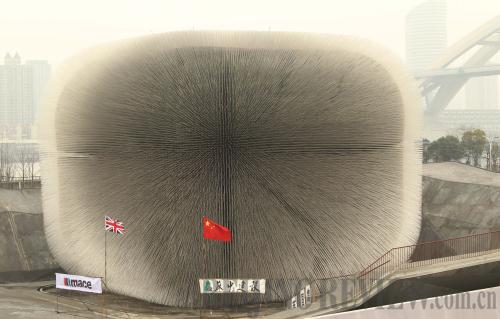|
Gömböc and Wooden Rods at Hungary Pavilion
(National Pavilion Day: August 22)
The Hungary Pavilion is decorated with hundreds of wooden rods. Every single element of the wooden installation performs like a musical instrument. The system of nearly 600 moving and light emitting sound boxes creates a wavering sound space. The inner space of the pavilion is illuminated by natural sunlight in the daytime, while at night it turns into a starlit sky through the lights built in the sound boxes. The hanging and vertically-shifting wooden rods will make visitors feel as though they are walking in a forest, and their rarefaction refers to glades, just like squares in the city.
Gömböc, a 2-meter-high solid plexiglass moving object, is the central element of the pavilion. Pronounced "goemboets," the new geometric shape created by Gábor Domokos and Péter Várkonyi is the first known homogenous object with one stable and one unstable equilibrium point, thus possessing a total of two equilibria on a horizontal surface.
It shares a close philosophical relation with yin and yang in ancient Chinese philosophy, both symbolizing the pursuit of harmony and balance. This is what Hungarians wish to achieve in urban development as well. Its harmonic movement is similar to the pulsation of a city; this feature is magnified by the structure of the pavilion through its dynamically shifting vertical wooden rod elements, creating density at the same time. The Gömböc stands as a symbol of dual harmony and equilibrium. The designers of the Hungarian Pavilion project this feature of the Gömböc upon the entire country: Just like the Gömböc, Hungary always recovers.
The Seed Cathedral at UK Pavilion
 |
|
STRETCHING TO THE FUTURE: Some 60,000 slender transparent rods form the six-storey-high "Seed Cathedral," the centerpiece of the UK Pavilion (REN LONG) |
(National Pavilion Day: September 8)
The centerpiece of the UK Pavilion is the six-storey Seed Cathedral formed from some 60,000 slender transparent rods, which extend from the structure and quiver in the breeze. During the day, each of the 7.5-meter-long rods act as fibre-optic filaments, drawing on daylight to illuminate the interior, and thus creating a contemplative, awe-inspiring space. At night, light sources at the interior end of each rod allow the whole structure to glow.
Inside the Seed Cathedral, which is the core exhibition of the pavilion, visitors will be invited to watch, touch and identify the seeds of different plants. They will be surrounded by seeds in the 20-meter-high hollow cube-like structure, with the seeds embedded in the walls and ceilings. The seeds demonstrate the concept of sustainability, the diversity of nature and the potential of life. n
| 